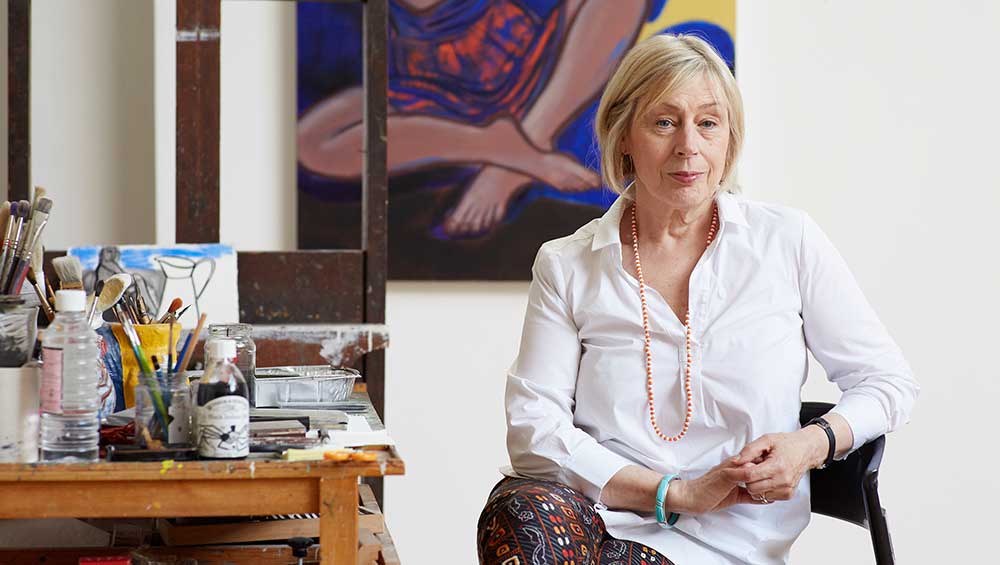
Eileen Cooper RA.
by JULIET RIX
These 22 large-scale drawings – some explicitly sexual – were all made between 1977 and 1982, the formative years after Eileen Cooper RA left art school – or rather after she left her third art school. Having done a foundation course at her local college of further education in Ashton-Under-Lyne, she took an undergraduate course at Goldsmiths (1971-74) before completing her studies with a postgraduate painting course at the Royal College of Art (1974-77). Significant works in themselves, these drawings also illuminate the development of some of Cooper’s most famous themes and her fluid figurative and figure-centred painting style. Her flowing lines, signature objects, focus on womanhood, and interplay between couples are all here, already taking off (sometimes literally) towards the work that would soon bring her success and recognition as an artist and teacher of artists.
Cooper taught at, among others, St Martins, Camberwell and Falmouth art schools, before finding her home at the Royal Academy, where she taught from 2005 until 2017. She had already been elected a Royal Academician in 2001 and, in 2010, became the first female Keeper of the RA in the institution’s 250-year history.
Born in 1953, Cooper grew up in Glossop, Derbyshire, living above her parents’ hardware shop. In 1971, she “escaped” to London, 200 miles away, settling in south London where she still lives today.
Studio International spoke to her at the gallery as the exhibition opened.
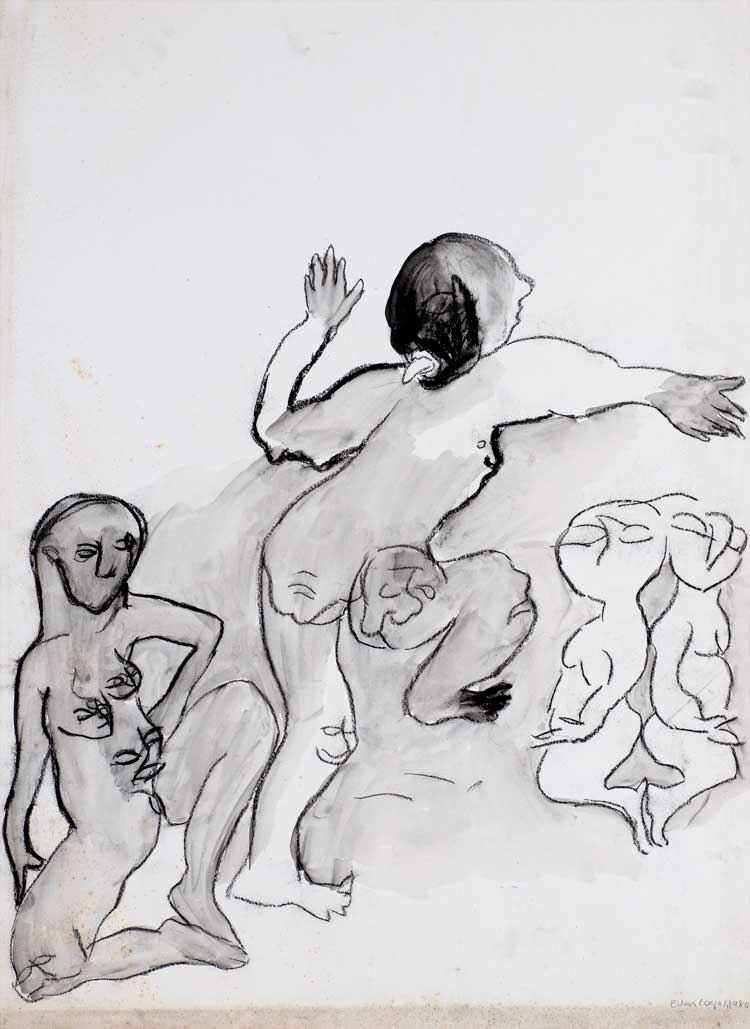
Eileen Cooper, Footsteps, 1980. Charcoal and pastel on paper. Image courtesy the artist and Huxley-Parlour.
Juliet Rix: These drawings were made in your little London flat soon after leaving the Royal College. Were they not then seen for four decades?
Eileen Cooper: It was a big decision to show these drawings. Nobody had seen them. I don’t think I even showed them to a friend at the time, and they were made without any hope of an exhibition. They were solely for me. Corny, I know, but they were about understanding the world; even cornier, about my own journey of self-discovery. I was working things out artistically and personally. I found them only about a year ago when I was clearing portfolios from a storage space. I was amazed at what good condition they were in and – if I’m allowed to say this – how good I thought they were.
JR: How lovely to find long-hidden early work you are proud of.
EC: I thought they were extraordinary, had great presence, and they were honest. I’ve always avoided looking back. I don’t want to rest on my laurels; my laurels aren’t in a good enough state to rest on! I’ve always wanted to be experimenting, improving, breaking new ground. But when I turned 60, I started to have to look back – for an exhibition, a book, a database – and it’s turned out to be fascinating.
I always thought my work hadn’t changed radically, but when I looked, it had. At the same time, all the things that troubled me as a young artist and a young woman formed the basis of what I do now. Many of these drawings connect with paintings I went on to make. Two relate to Clued In (Following in Footsteps) (1980), which is all about spying, being watched. I’d been looking at Artemisia Gentileschi’s Susanna and the Elders (1610) and, of course, as a young woman you do feel watched. They were not preparatory drawings in the traditional sense; they were not made with a particular painting in mind. They were works in themselves, but then they led to paintings. Maybe the next stage for me is to go and unwrap some of those old canvases.
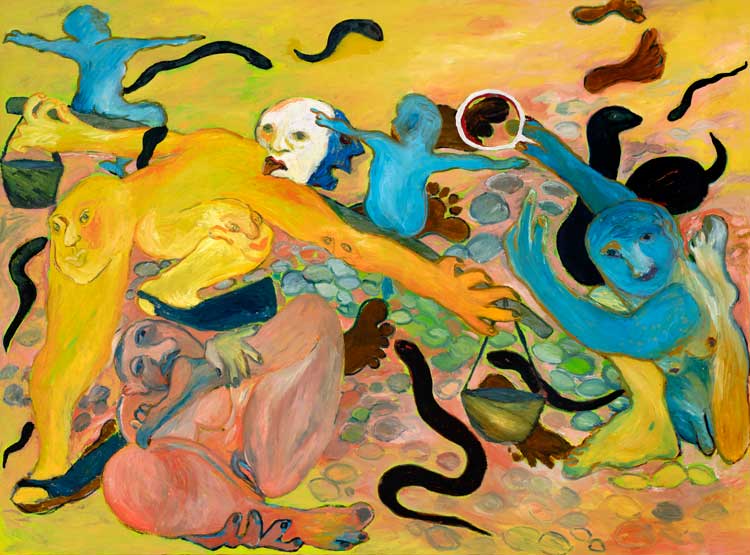
Eileen Cooper, Clued In (Following in Footsteps), 1980. Image courtesy the artist.
JR: These drawings date from the late 1970s and very early 80s and your work has long centred on the female experience. To what extent was the women’s movement of the 70s important for you?
EC: It was massive. I don’t know that I engaged very directly with it, but it changed everything. My generation was the first to get the pill. Women were no longer trapped in unwanted pregnancies like my mother’s generation. And it wasn’t just women’s liberation but gay liberation too. It was the beginning of what we have now – so much more visibility for female artists and so much more diversity – a really healthy thing. I’ve always had an emotional response to politics, and that early feminist statement, “The personal is political,” always resonated with me. I’ve never been an activist with a big “A”, but with a small “a” maybe.
When I was at Goldsmiths, there were very few female artists exhibiting and very few teaching at art schools, although there were lots of female students. I was very aware of what was happening in the US with female artists and feminism – artists such as Judy Chicago. I’ve never been a great consumer of art magazines, so my awareness would have come through word of mouth or a (male) tutor asking me: “Are you a feminist artist?”
JR: And were you? Are you? How did you answer that?
EC: Oh God, am I? What does that mean? I doubt I really answered it, or I may have just said: “Yes, of course.” Organically, I knew this was something other women were shouting about that I wanted to be part of. I think I’d known from about the age of three that I didn’t want my mother’s life, that I wanted to escape that “woman’s role”, to challenge that.
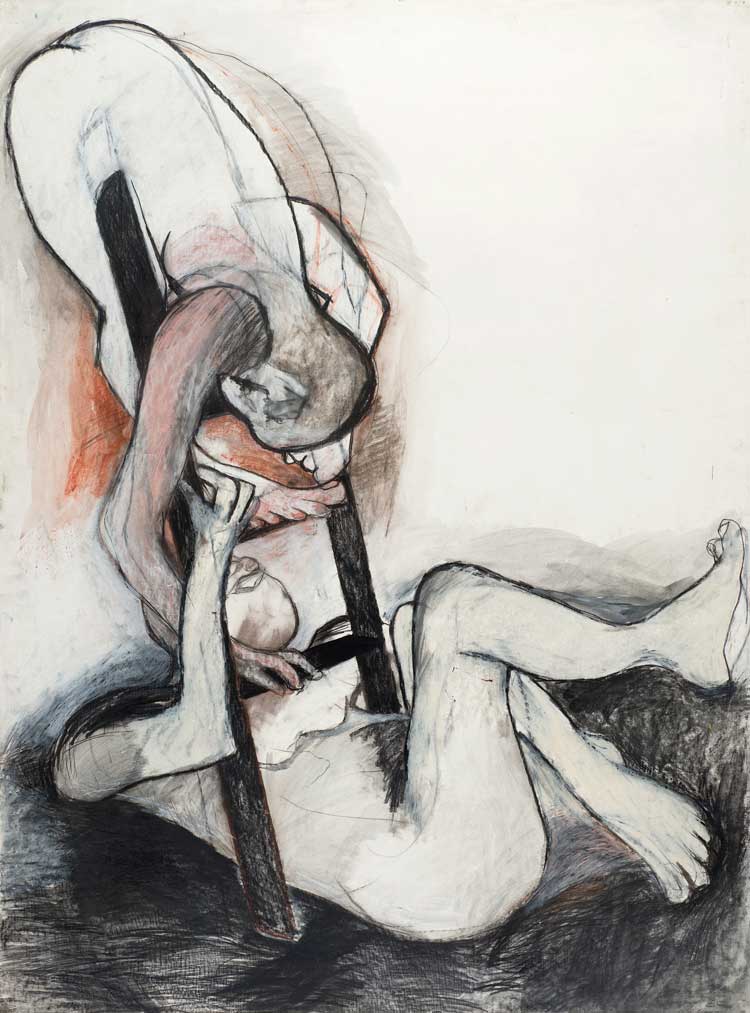
Eileen Cooper, The Ladder, 1979. Conté and charcoal. Image courtesy the artist and Huxley-Parlour.
JR: So, feminism was an important part of what you were doing?
EC: Yes, even though I didn’t necessarily understand it. I wasn’t a card-carrying feminist. There were all those caricatures of feminists bra-burning – such a cliche. I never joined a women’s group. It all seemed to me a bit middle class (which I wasn’t) and I had so much happening; I wasn’t stuck at home with a child. A women’s group just wasn’t something I needed.
JR: Some of these drawings have a strong sexual element.
EC: They do, and it was a big decision to show those. I hope I don’t get too embarrassed. At 70, maybe I should finally give up being embarrassed.
I can’t remember many people who were working like this at that time. There was Helen Chadwick, who was exactly my age (and died horribly young), who was dealing with sexuality in very different ways, using herself in her photographs. So, there were other women of my generation who had experienced the same awakening and enablement as I had, but I don’t think many women artist in the UK were doing work like this, certainly not in imaginative drawing.
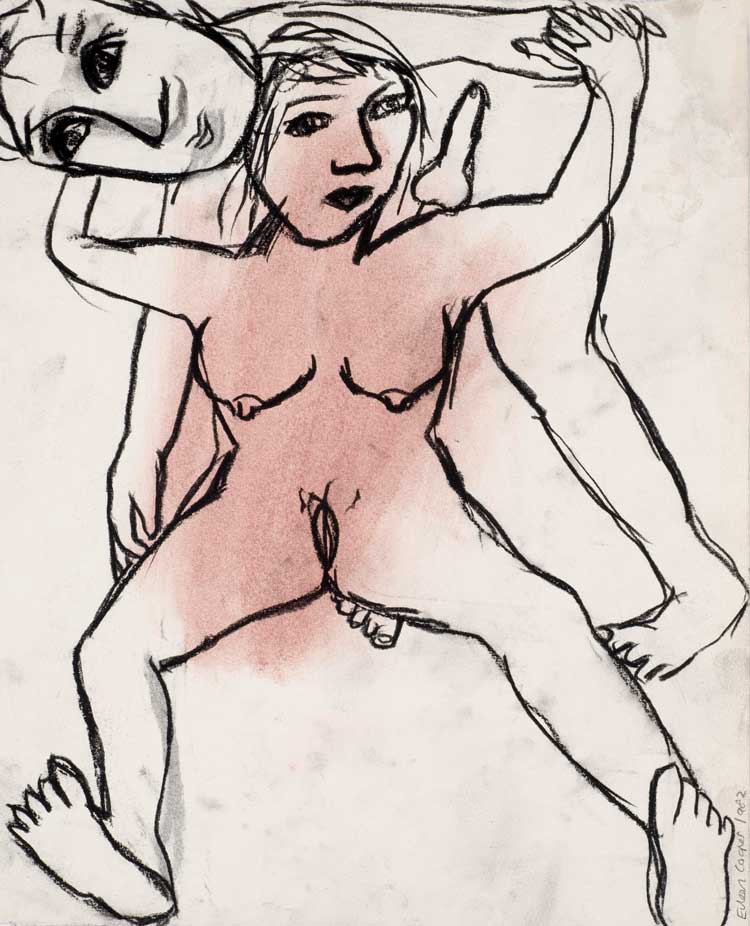
Eileen Cooper, Sex and Love IV, 1982. Pastel and Conté on paper. Image courtesy the artist and Huxley-Parlour.
The early drawings are non-gendered, which is, of course, a very current idea. At first I felt that the sexual characteristics were kind of interchangeable; whether this was a male body or a female body didn’t really matter. But soon they became very clearly male or female, and that’s when the sex drawings happened.
I also wanted to look beyond western culture, beyond [Ernst] Gombrich and the National Gallery. I remember looking at Penny Slinger and Nik Douglas’s The Pillow Book, a collection of Indian and South Asian, Japanese and Chinese so-called erotic art – amazing explicit non-western images. I particularly loved the Japanese Shunga prints, all those flowing kimono forms, people making tea and making love, very detailed sexual organs and abandon.
JR: It is interesting that you mention “abandon”. I find looking at your drawings and paintings, particularly of couples, that two words that come to mind are connection and abandon. Would you regard that as appropriate?
EC: Yes, that’s a good fit. I take that as a compliment. And, of course, the drawings were personal, too. I was a young woman fascinated by erotic art as an idea, asking myself, was it just for dirty old men?
JR: And you concluded that it wasn’t, that it isn’t?
EC: Absolutely, it isn’t! And there’s an equality in these drawings. Neither person is being exploited. They are also about the body (my work is always about the body). I think you can tell from the drawings. It was about bending the body, working out how it fits into a rectangle. My figures are nearly always touching the edges of the rectangle, as if the world is condensed into that painting or that drawing, which adds to the intensity of the act, I suppose.
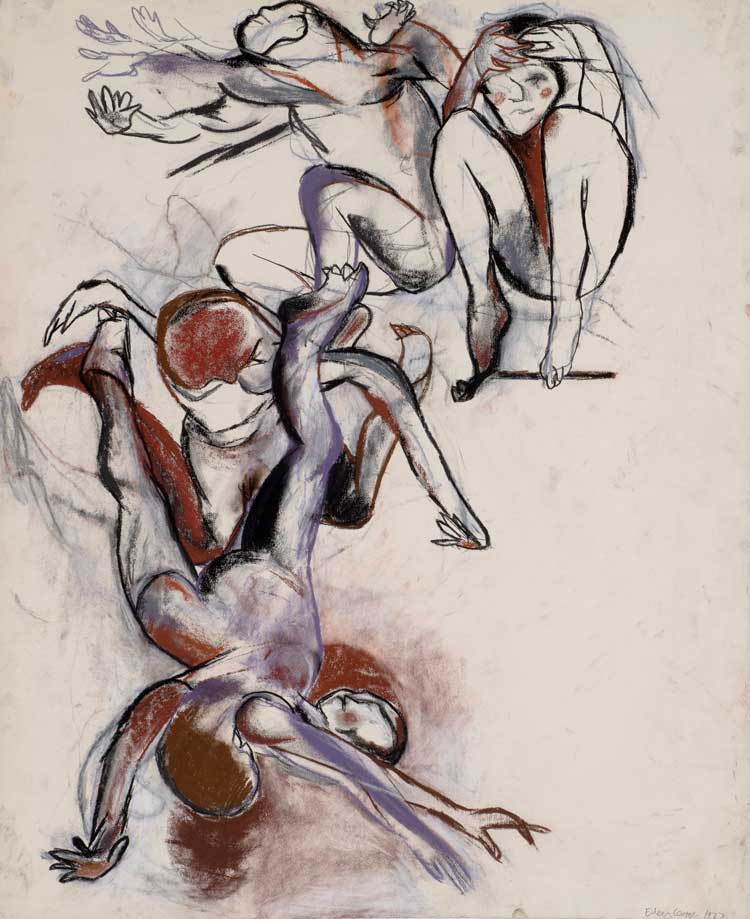
Eileen Cooper, Leap, 1977. Pastel and Conté on paper. Image courtesy the artist and Huxley-Parlour.
JR: Do you remember doing these drawings?
EC: Yes. I particularly remember making Leap and Handstand (both 1977). Both are ungendered. And Stages (1979), which was almost the start of the swing motif – the body leaping, turning, tumbling, falling. This was the time when I developed those recurring objects – the mirror, the ladder and the swing, which sometimes becomes a trapeze.
The swing developed out of wanting an upside-down figure, a figure floating through air, and thinking how can I make that logical, convincing? Ah, a swing! And looking at [Gustave] Courbet’s The Hammock and [Jean-Honoré] Fragonard’s The Swing and wanting to remake them from a female point of view. The swing then resonated with the fear you have as a young kid swinging higher and higher: it’s terrifying, and kind of orgasmic as well.
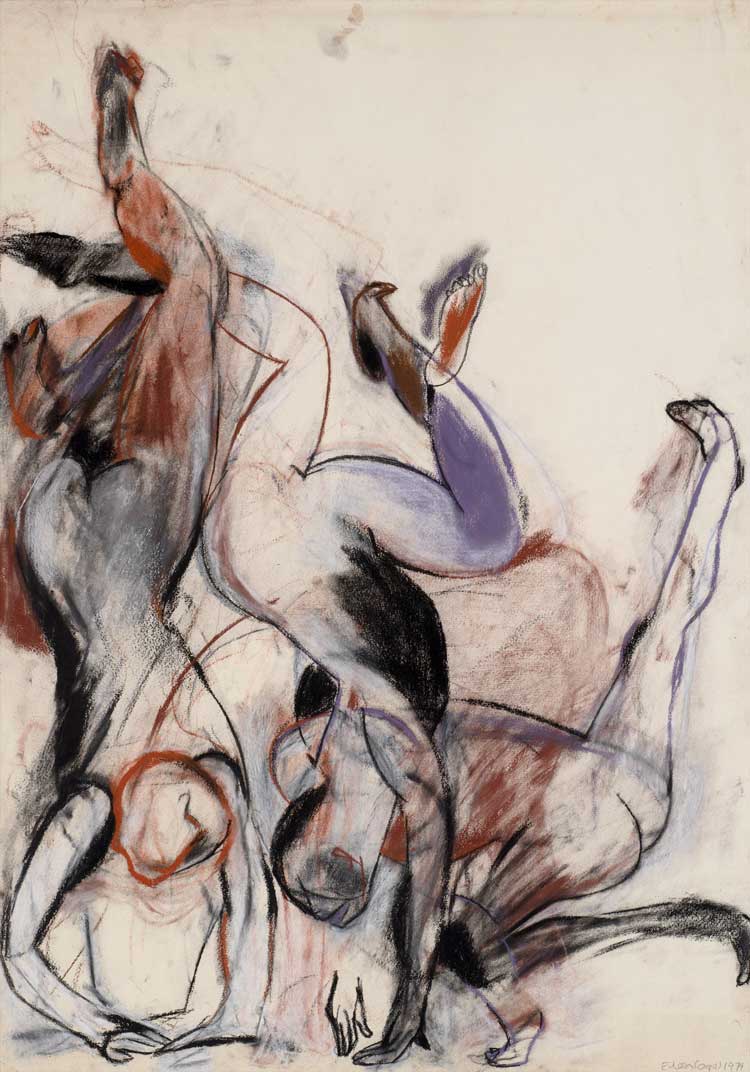
Eileen Cooper, Handstand, 1977. Pastel and Conté on paper. Image courtesy the artist and Huxley-Parlour.
In Handstand, the body is going through stages too. You see where the hand goes, pushing itself up into the next stage and the next stage until, finally, there’s a handstand. And here I was also experimenting with Conté. These drawings were about trying out process and materials as well as images and ideas. They move from graphite to Conté to pastel, on different coloured papers, and rough paper, smooth paper – anything I could get my hands on, nothing precious. All that energy in them.
I remember the two mirror drawings: Mirror and Seeing (both 1979). Duality and twinning are a big thing in my work; I keep returning to it. The figure in Mirror is very much female – a woman with her legs in the air, the legs against the mirror. I had set up a mirror in my tiny council flat in Deptford and I had used myself as a model, but this drawing wasn’t that. I drew this from imagination, using what I had discovered from the mirror – the personal journey asking who is this person, what is happening, is this a way of seeing?
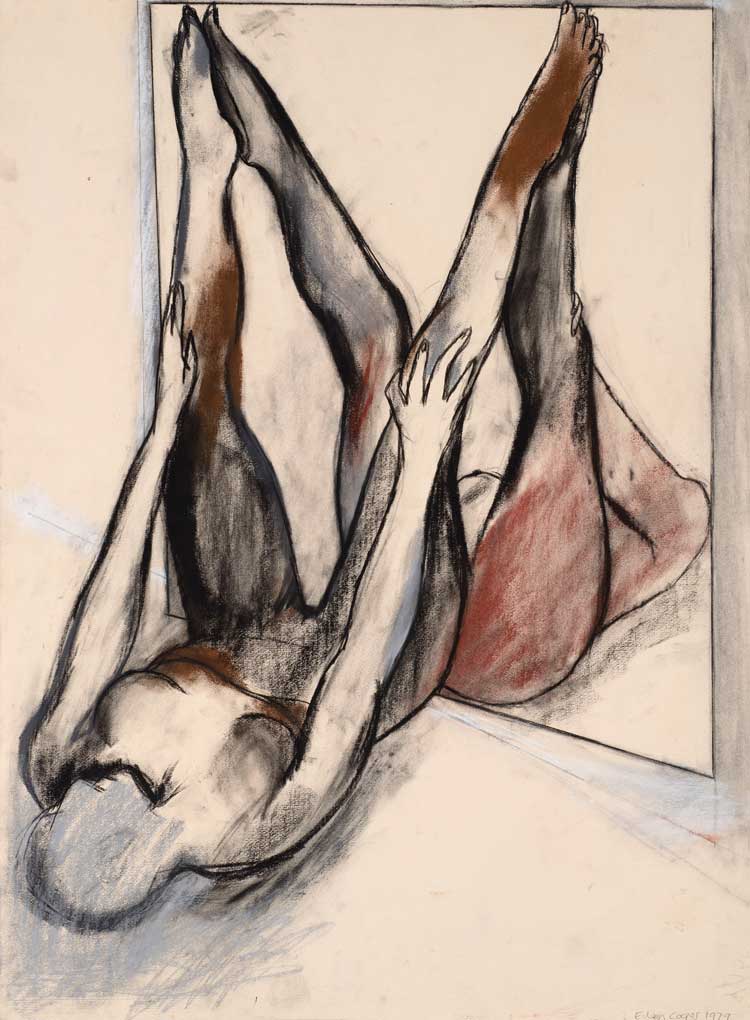
Eileen Cooper, Mirror, 1979. Pastel and Conté on paper. Image courtesy the artist and Huxley-Parlour.
JR: Exploring the self?
EC: Yes, I had drawn myself. I’d even put the mirror on the floor and drawn from the toe up – a different way of seeing the body. But the drawings in this show are all from imagination.
JR: Drawing has always been important for you, hasn’t it?
EC: Absolutely. And even in the paintings I start by drawing with paint. I’m very comfortable with a piece of charcoal, it feels very fluid, and paper isn’t the investment of finance, time or emotion that canvas is, so it’s freer. I could still be a very content artist if I could only have paper and charcoal.
JR: You can afford to be more experimental on paper?
EC: You can try things out, there’s no pressure. You can rub out, tear and reassemble, start another one. It’s exciting. It’s how I get ideas flowing. When you are drawing, unpredictable things happen. And the history of what you’re trying out is more visible in a drawing too. Paint covers it up, but in a drawing if you rub something out, there’s often a residue, you can tell where a figure has moved.
JR: The picture’s own story within the picture?
EC: Yes, you can see the story of its making. A figure might be standing but also sitting because you’ve changed it. I love that in other people’s drawings as well.
JR: Anyone in particular?
EC: You see it in Goya, certainly in Picasso, and in the German expressionist drawings of Max Beckmann and Paula Modersohn-Becker, and amazing Käthe Kollwitz drawings, which are so intense.
JR: Do you think you were consciously, at the time of these drawings or later, making art for women, as well as making art about women and as a woman?
EC: Hmm … I think I just made it for myself and I’m a woman. But I’ve always had men responding to my work. I’ve never alienated men – and never wanted to. Often the woman is the main protagonist, though. She may be gardening and the man may be assisting or sleeping. The woman usually takes centre stage.

Eileen Cooper, Small Reflection, 1979. Pastel and Conté on paper. Image courtesy the artist and Huxley-Parlour.
JR: In 1980, you had work in the ICA Exhibition, Women’s Images of Men, a show now seen as pivotal. Did it seem important at the time?
EC: I think it’s become more important with hindsight. It will be strongly referenced in the Tate exhibition that is coming up in the autumn, Women in Revolt! Art, Activism and the Women’s Movement in the UK 1970-1990. It’s a big survey show, with as many as 100 female artists and I’m very excited to be a part of it. I’ve got a large-scale ladder drawing in it from 1979, the same period as the drawings in this exhibition.
The essay that Linsey Young (curator of the Tate show) wrote for my 2022 exhibition Parallel Lines, at Leicester Museums, talks particularly about that ICA show and the terrible criticism from the male critics. Waldemar Januszczak in the Guardian said the work was blaming men for absolutely everything, and John Spurling in the New Statesman wrote: “These artists strike one as dilettantes, people who don’t invest much of themselves in their art.” You could fight back against that sort of review now, but you couldn’t then.
JR: Did the ICA show help you personally?
EC: The show caused a bit of a storm, and I came out of it quite well. A lot of the other artists had turned their backs on painting and were working in multimedia and early video installations, so my work stood out because it was painting. Off the back of it, I was approached by a gallery, Blond Fine Art, and started to show commercially. I hadn’t expected that. I didn’t really think there’d be a market for my work. As a student, I had no expectation of showing or selling my work. I thought that might happen when I was 40, if I was lucky. I was making my living in other ways. I worked in youth clubs, I was a play leader for the Greater London Council (GLC), I worked in supermarkets …
JR: You didn’t think of art as a way to make a living?
EC: No, none of us did.
JR: Did some of the men perhaps?
EC: Perhaps, but it wasn’t until my third solo shows that I thought maybe I was an artist and I wouldn’t have to give it up and do something else. After the ICA show, though, I quite quickly began to get art school teaching and recognition for my work. By the mid-80s, I was really flying and was well covered by newspapers and reviews. Sales were still slow. I don’t think there was a massive culture then of people buying contemporary art in this country. We used to note that German dentists were buying contemporary art while dentists here were buying antiques. The market didn’t take off in the UK until the late 80s and 90s.
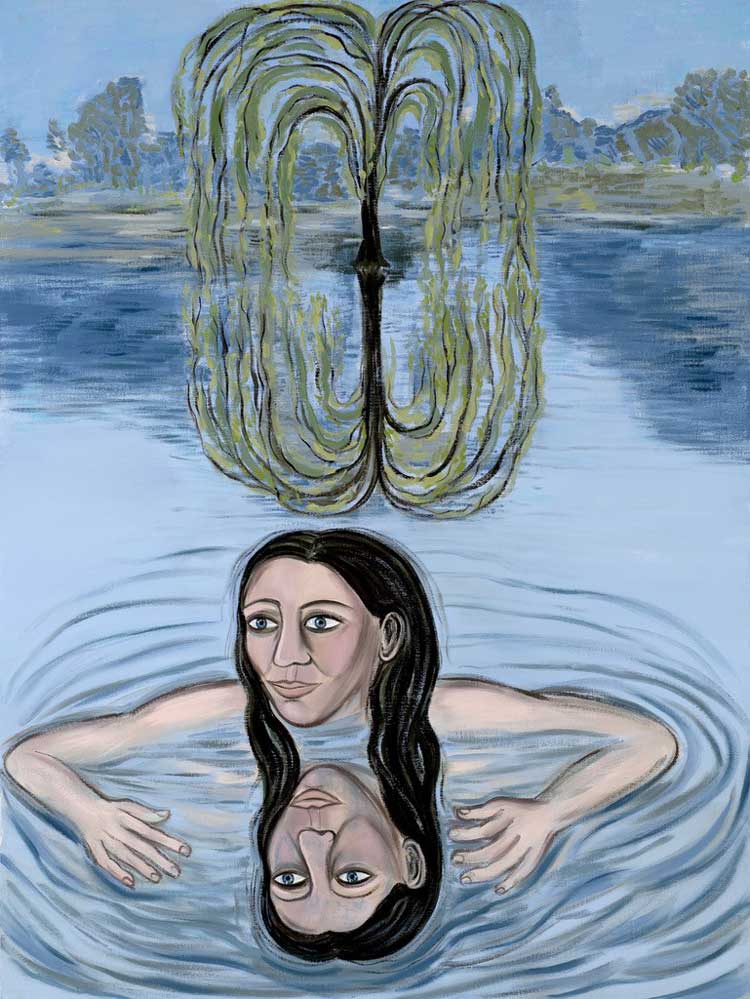
Eileen Cooper, The Wild Place, 2022. Image courtesy the artist and Huxley-Parlour
JR: By then you were well established, but also had the distraction of two children – two sons?
EC: I do remember the smug feminists who had the one perfect daughter and I’d let the side down by having these two rough lads. I loved my boys and they taught me so much. And when they got older, and pre-teen/early teenage girls started to come into the house, I was so used to boys that I found the girls really alien! Now I’m amazed – and delighted – that I’ve got a granddaughter.
I do look back at those years of having children, from year nought to about 20, and think where did those years go for me? I was a mother, I had my partnership with my husband, I did the work, I did my teaching, but I couldn’t be involved in developing my career in the way I am now. There were things I didn’t go to that I should have gone to because I didn’t want to get on a plane. I took a bit of a backseat. You really need to be central to your career as an artist, to own it, and I didn’t. I had too much else going on.
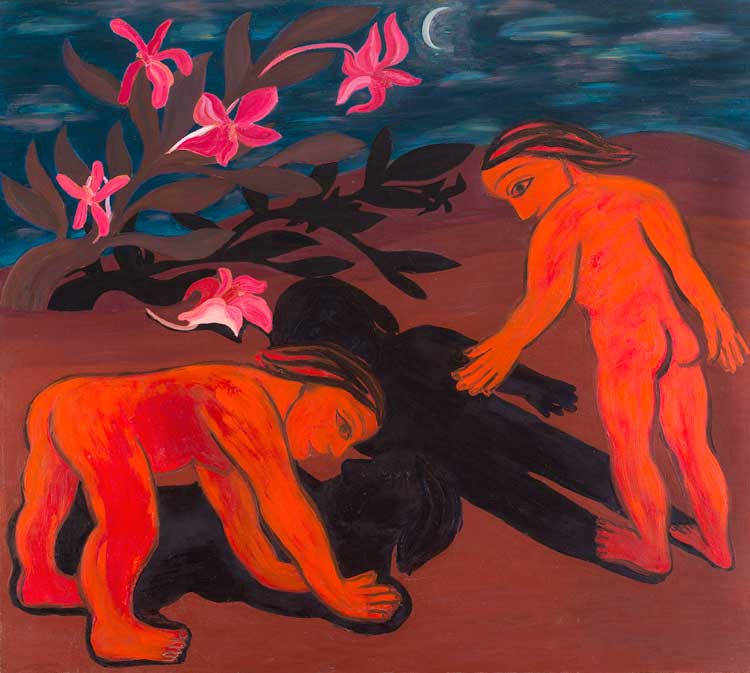
Eileen Cooper, Woman Examining Her Shadow, 1988-89. Image courtesy the artist.
JR: It doesn’t seem to have stopped you being very successful?
EC: Tate didn’t acquire a piece of mine until very recently and I sometimes wonder if, had I been more in control of my career, it might have happened earlier. It has now acquired Woman Examining Her Shadow (1988-89), and I’m particularly pleased it has that one. I bought it back from a collector (a weird thing to do when you are trying to make a living and get work out into the world, but I’ve bought back a few) and it was my first choice to go to Tate.
For a long time, the museum’s selection of work was quite misogynistic. My work was seen as too emotional, especially when it was about having children and nurturing. The few pieces of women’s work that were bought, I always thought looked like men’s work. Now the museums are really redressing the balance and playing catch-up.
JR: The Tate show is called Women in Revolt. Has there been a revolution?
EC: I’m not sure. There’s definitely been a change. I think it’s tough now for emerging male artists. What we all want really is equality, equal opportunity. But is work ever solely judged on its qualities? Context is so important. There is a lot of reinterpreting going on now. I thank God that’s not my job.
JR: You are very much in touch with the next generation through your family and your many students. You gave up teaching in 2017. Do you miss it?
EC: I was ready to stop. But I did love being involved in my student’s work – especially the ones who were struggling. I never taught full time, though, and I was fortunate to teach at a high level. I taught Peter Doig – such a great artist – and Isaac Julien, Rachel Jones, Hannah Perry, Liane Lang, Eddie Peake … I had amazing students.
Looking at these drawings I did in my 20s reminds me that I used to say to my students: “You may be only 22 and know very little about the world or about your materials, but you can still do great work.” It’s kind of like working blindfold. I’m now at the other extreme. I know those processes so well that it’s hard to subvert myself. That’s one of the reasons I now soak up new experiences, doing all kinds of printmaking, collage, ceramics … I even made some bronzes. I like difficulty. I need to be unsettled.
When I stepped down from my role at the Royal Academy, I had a hankering to unsettle myself, so, in 2018, I started making portraits. I turned my back on drawing from life when I was a student, really rebelled against it, preferring to draw from imagination, memory and feeling. It’s been very exciting to return to it.
I asked some of my ex-students to sit for me. I live in south London and they all seem to live nearby. Doing these portrait drawings has been really joyful. I’ve probably got about 100 now. The sitting is two to three hours, with a lot of chat – and a bagel and biscuits. Then I take photographs and they go away and I carry on working. The drawings tend to be about life size, sometimes larger. I don’t seem to be able to control them – sometimes I add paper.
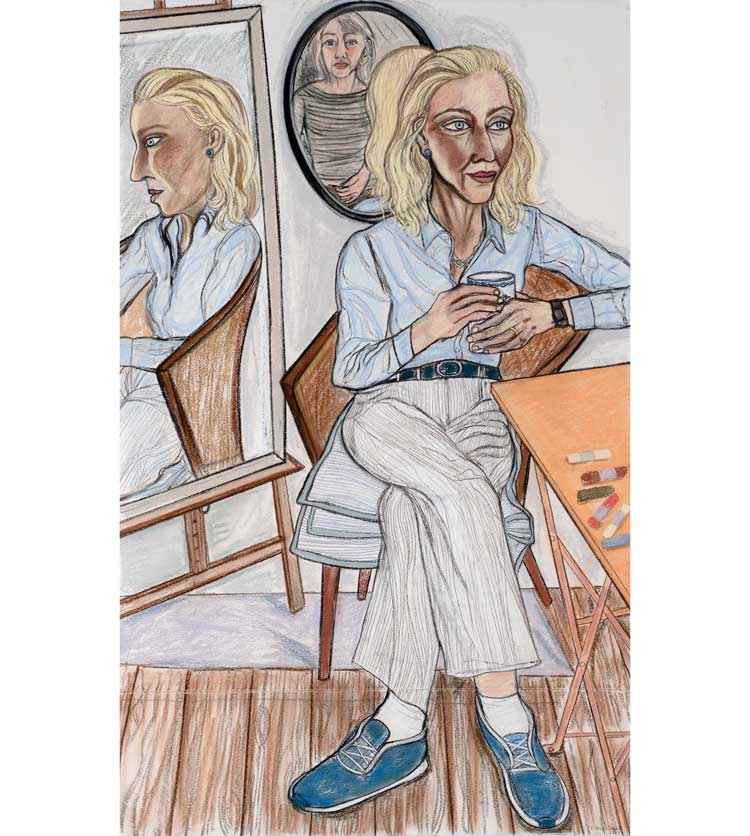
Eileen Cooper, Katrin Bellinger, 2023. Image courtesy the artist.
Most of the first group were my graduate students, including Rachel Jones and Eddie Peake, as well as Coco Crampton, Gabriella Boyd, Sikelela Owen and Prem Sahib (lots of my students have become well-known artists). Then I started adding portraits of other people important in my artistic life: art historian Frances Borzello (who has written so much about female artists), the collector Katrin Bellinger, and a fantastic artist, Uduehi Imienwanrin, who works with Intoart in Peckham, south London [a charity and art school for people with learning disabilities]. I am planning to draw Mark Golder and Brian Thompson, who for decades have been quietly buying prints and ceramics and giving them to smaller museums. They’ve given so many prints to Pallant House among other places, they deserve more recognition.
JR: The newly refurbished National Portrait Gallery has just acquired a couple of your portraits, hasn’t it?
EC: Yes. Self-Portrait in Black Dress (2019) and Cathie Pilkington RA (2019). They aren’t on show at the moment, but I’m told they will be next year.
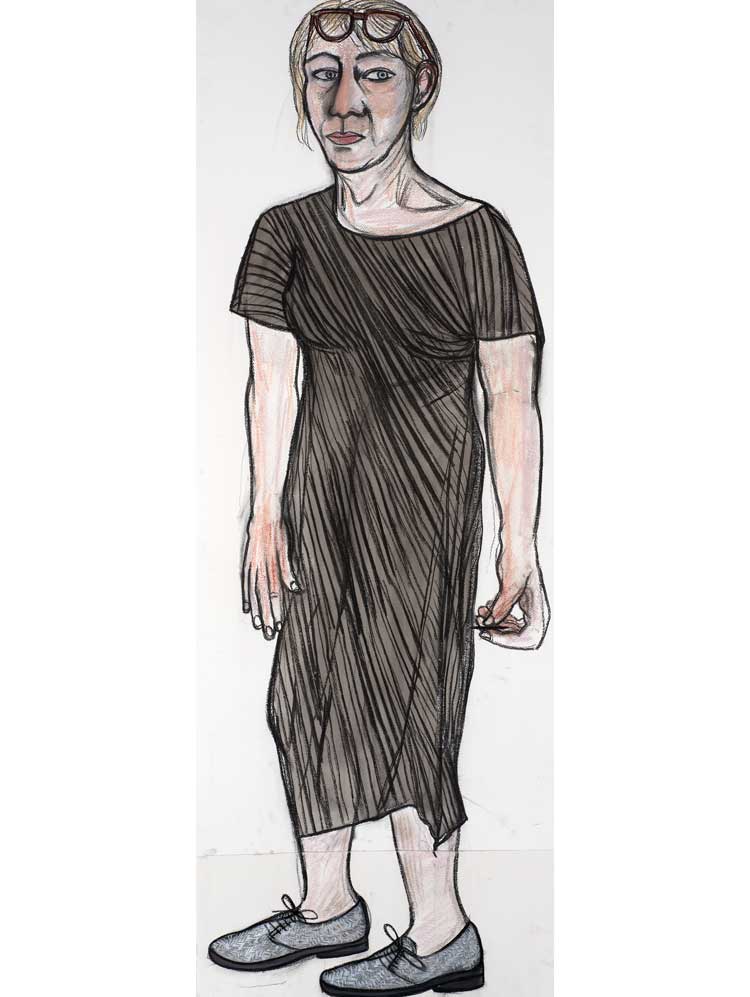
Eileen Cooper, Self-Portrait in Black Dress, 2019. Image courtesy the artist.
JR: You are still painting with your signature style as well though, aren’t you, and your figures are quite recognisable. How much did they originally develop from self-portraiture?
EC: They did come from a sense of self, but they also came out of the art I was looking at and responded to most: German expressionism; the pattern and rhythm of Indian miniatures and Japanese prints, Frida Kahlo, and Picasso – so much in Picasso resonates with me.
JR: Does Picasso’s treatment of women bother you?
EC: No. Can I say no? Perhaps he was a complete monster, but would I censor his work because of it? No. I’m sure Edgar Degas, whom I adore, and Titian, whom I adore, were far from PC. If this is something the younger generation want to really interrogate, I’m not going to stand in their way, but, for me, I can separate out the achievements of the work. That said, there are one or two artists who do make me uncomfortable. I’ve always found Paul Gauguin difficult – I’ve always felt he was exploiting these available young women in a very shocking way. And some of Lucian Freud seems to me to be like that too – a bit exploitative. I’m not sorry to see that being taken apart a bit.
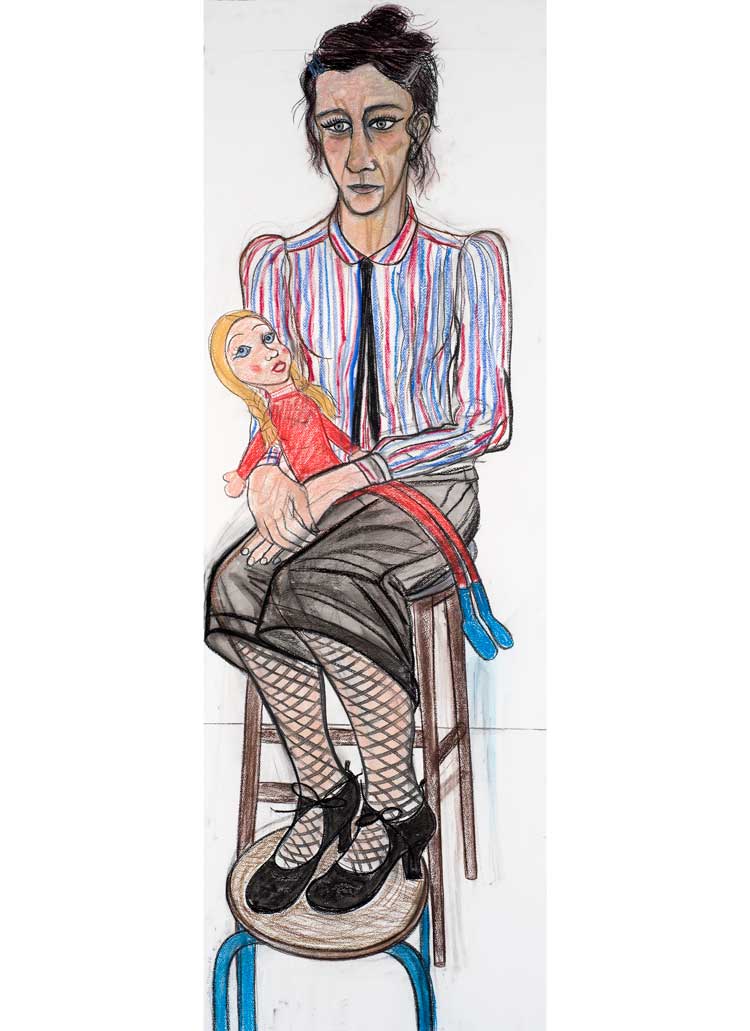
Eileen Cooper, Cathie Pilkington, 2019. Image courtesy the artist.
JR: How do you connect with the work of the late (so recently late) Paula Rego? Your figures have something in common and you both major on the female experience, but in very different ways.
EC: I want it to be in a different way. We are a different generation, although we emerged at the same time, and we were friends and we bought each other’s work. Obviously, as I became entrenched in motherhood and she became hugely successful, we saw less of each other, but she’s somebody I rate hugely. I know the struggles she had with her work when she went from the more imaginative to the territory that is a bit more Freud. And I don’t think she was ever completely comfortable with paint. It was when she started doing those big pastels that it all really kicked off for her. She’s a fantastic artist. I love her bravery and her mischievousness. I feel lucky to have known her and to have seen her getting her due.
I think I’m rooted in a very different place, though. She became clearly narrative. I’m less narrative, more lyrical, coming from a different imaginative space.
JR: Most of her work is about pain in one way or another?
EC: I think that’s true and I have sometimes wondered if that contributed to her success. Is there a slightly sexist approach to women’s art that if the woman suffers – like Paula, like Frida Kahlo, like Tracey Emin, like Louise Bourgeois – that is somehow as it should be? My work isn’t like that – especially the work about motherhood, which is much more upbeat and optimistic, although I have made some work about loss, particularly about my mother dying.
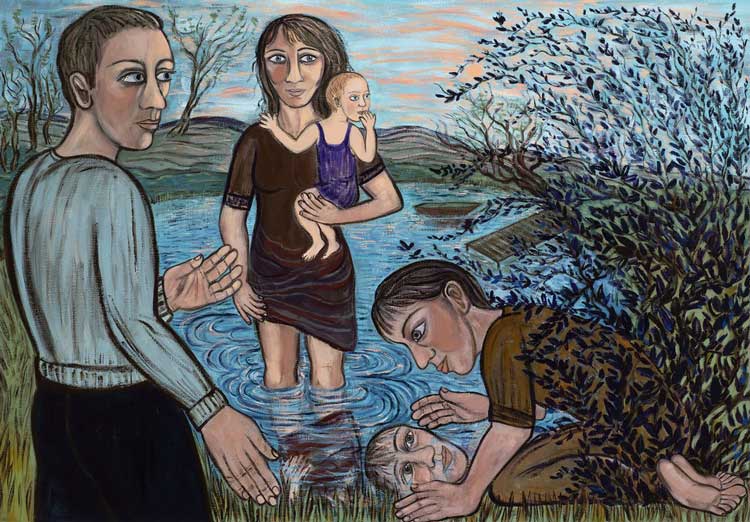
Eileen Cooper, Walking in Circles, 2021. Image courtesy the artist and Huxley-Parlour.
JR: You and Paula Rego certainly had a different approach to motherhood.
EC: She would lock the studio door. My studio door was always open. My kids came in on their rollerskates, there were footballs flying around, hockey sticks. They always had art materials and sketchbooks – my way of shutting them up – and they thought you could make anything out of a cardboard box, a cereal packet or an old sock. I’ve never been able to separate family from work, and I’ve learned so much from my kids – and from my students.
JR: Did you notice any difference between the male and female students?
EC: As a teacher, I always got on very well with my students, male and female. Were they different? There was one thing that drove me mad. The RA gets no public funding and charges no fees, so we had to fundraise and we made little films to help. All the male students were happy to be in them, but none of the female students would do it. I said: “You’ve really got to!” I found that, in my role as Keeper of the Royal Academy, I had to force myself to get up and make those speeches and do those interviews, and now they don’t faze me at all.
JR: You are a great defender of the RA, aren’t you – and of the Summer Exhibition?
EC: I believe in the RA Summer show. It’s the nicest time at the Academy when the artists have taken it over. I don’t like hierarchies, and although, of course, the hierarchies are still there and the RAs hang their own work, I love that you can also bring in people who would not normally have such a great spot and hang them alongside. In one of the rooms I curated this year, I discovered I had printmakers in their 80s and 90s, and one in their 100s – all women, all still making work. And there are people whose first exhibited painting this is, and all sorts of people not normally exhibited. It’s easy to take a swipe at the RA, but it’s a good organisation. We’ve even got our first female president in Rebecca Salter. I feel very lucky to be an RA and to have the wide audience that brings me.
JR: How do your sons see your work?
EC: I think they are both incredibly proud of me. I don’t know how closely they want to be involved, but I think it’s just dawning on them that there’s going to be this legacy, my estate. It’s a bit of a grim thought for them, but I hope it will be empowering for me to put together a database of my work. Obviously, I’m going to live for a hell of a long time because I’ve got all this work to do, but I’ve got so much I’m leaving behind. That’s part of the reason to show these drawings. If not now, when? And there are more drawings – from 10 years later, and from 10 years after that.
Maybe this show is a milestone. I’d like to do more exhibitions that are sort of cross-generational within my own work. And looking back at the drawings in this show is, I think, going to have an impact on the work I do next.
• Eileen Cooper: Ambivalence and Desire is at Huxley-Parlour, London, until 2 September 2023.